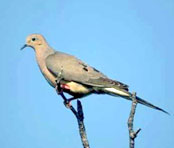 Mourning Dove Mourning Dove
Zenaida macroura
This common dove
is gray-brown with a black spot on its cheeks. It has a slim body,
small head, pinkish feet, and a long pointed tail. The wings
produce a whistling sound as the dove takes flight and the white
tips of the outer tail feathers are visible. Small flocks are often
found feeding on the ground or perched on wires or tree branches.
Its flight is swift and direct without coasting. Its call is a
series of mournful coos. It lays 2 white eggs in nests in trees,
shrubs, or on the ground. 12 in. |
|
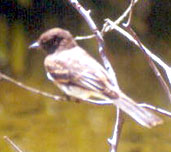 Black Phoebe Black Phoebe
Sayornis
nigricans
The black phoebe
is a solitary flycatcher that feeds almost entirely on flying
insects. It perches in the open near water, wagging and spreading
its tail. It makes short flights to catch insects, and returns to
its perch. The top of its body, including the breast, is black; the
belly is white. Its 4-syllable song is a thin, rising pee-wee,
followed by a descending pee-wee. Its calls include a loud
tsee and a sharper tsip. It lays 3-6 white eggs in a
cup nest of mud and grass built beneath an overhanging cliff or
eave. 6-7 in. |
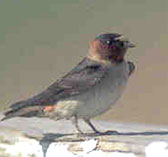 Cliff Swallow Cliff Swallow
Hirundo
pyrrhonota
Swallows have
streamlined slender bodies and long pointed angled wings. They
often perch in rows on wires and dart over water to catch insects in
their wide gaping beaks. The square tail and buffy rump distinguish
the cliff swallow from all others. Cliff swallows gather mud from
the edge of the Lagoon that they use to build colonies of
gourd-shaped nests under the eaves of nearby houses. On March 19th
each year (St. Joseph’s Day), the return of cliff swallows from
their wintering grounds in South America is celebrated in San Juan
Capistrano. |
|
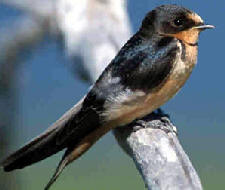 Barn Swallow Barn Swallow
Hirundo rustica
The Barn Swallow can be told from all
swallows by its deeply forked tail. Length is about 6 inches and has
a dark orange forehead and throat. With pale orange underparts.
Will nest communally in mud nests under bridges, in barns and caves. |
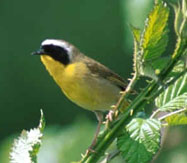 Common Yellowthroat Common Yellowthroat
Geothlypis
trichas
This small
wren-like warbler has olive-colored upper parts and yellow under
parts. The male has a black mask, bordered above by white, that
wraps across the top of its bill and around the front of the head.
The yellowthroat is often found on or near the ground in dense
patches of tules and cattails in marsh habitats. Its song,
witchity, witchity, witchity, witch, is
repeated several times. It lays 3-5 spotted eggs in a loose grass
cup. 5 in. |
|
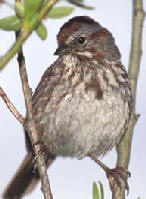 Song Sparrow Song Sparrow
Melospiza melodia
The song sparrow
is brown with a heavily streaked breast and a central dark
“stickpin”. Its legs and feet are pinkish. It pumps its long,
rounded tail in flight. It inhabits dense streamside thickets and
moist wood margins. Its song is a series of variable musical and
buzzy notes: sweet, sweet, sweet. Its call note is a hollow
chimp. It lays 3-5 spotted eggs in a grass cup on the ground
or in a bush. 6 in. |
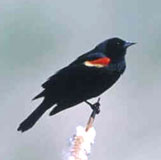 Red-winged Blackbird Red-winged Blackbird
Agelaius
phoeniceus
Blackbirds are
found year round. The shiny black males have bright red
yellow-margined shoulder patches that are hidden when feeding or
resting and are only seen during flight. Females are brown with
dark stripes. Males and females form separate colonies except
during the breeding season. |